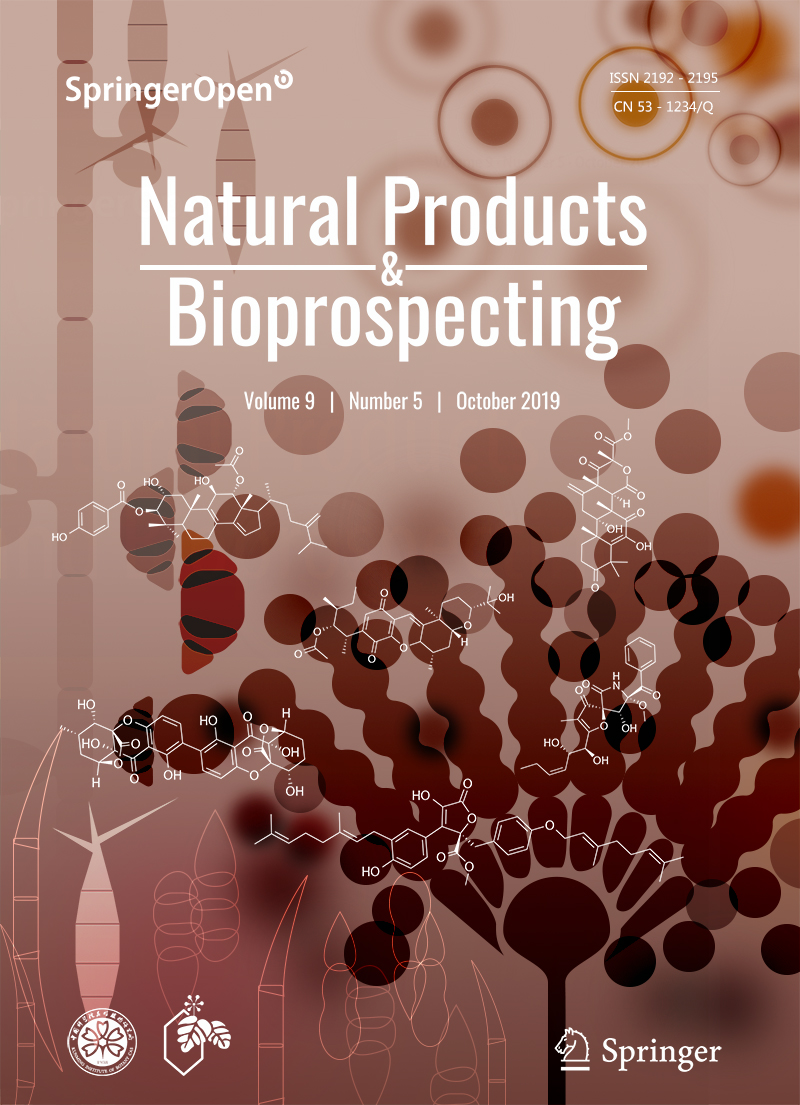|
|
Phenolic Constituents with Antioxidative, Tyrosinase Inhibitory and Anti-aging Activities from Dendrobium loddigesii Rolfe
Collect
Rui-Jing Ma, Liu Yang, Xue Bai, Jin-Yu Li, Ming-Yan Yuan, Ya-Qin Wang, Yong Xie, Jiang-Miao Hu, Jun Zhou
Natural Products and Bioprospecting. 2019, 9 (5): 329-336.
DOI: 10.1007/s13659-019-00219-y
Aqueous ethanol extracts of powdered stems of Dendrobium loddigesii afforded three new phenolics including threo-7-O-ethyl-9-O-(4-hydroxyphenyl)propionyl-guaiacylglycerol (1), (R)-4,5,4'-trihydroxy-3,3',α-trimethoxybibenzyl (2) and (S)-5,5',7-trihydroxy-3',4'-dimethoxyflavanone (3), together with eleven known analogues. Their structures were determined by extensive spectroscopic analysis. To identify natural antioxidants, whitening, and anti-aging agents, the abilities of these phenolics were assessed to scavenge the 1,2-diphenyl-2-picrylhydrazyl (DPPH) radical, their abilities to inhibit tyrosinase production, and their abilities to stimulate collagen production by human dermal fibroblasts-adult (HDFa) assay. It was found that compounds 1, 4-8, 13 and 14 exhibited significant DPPH radical scavenging activities, compound 10 exhibited tyrosinase inhibitory activity (IC50 37.904 μg/mL), and compound 9 showed significant collagen production with an EC50 value of 3.182 μg/mL. These results suggest that phenolic constituents from D. loddigesii may be candidate antioxidants, skin-whitening and/or anti-aging agents.
References |
Related Articles |
Metrics
|
|
|
Effectiveness of Echinochrome on HFD-Induced Hyperlipidemia in Rats
Collect
Sohair R. Fahmy, Nashwah Ismail Zaki, Shaimaa Zakaria Eid, Ayman Saber Mohamed, Sarah S. Hassanein
Natural Products and Bioprospecting. 2019, 9 (5): 337-344.
DOI: 10.1007/s13659-019-00221-4
Obesity has been identified with an expanded danger of a progression of illnesses that include different organ-frameworks of the body. In the present examination, we evaluated the hypolipidemic properties of Echinochrome (Ech) pigment in a highfat diet (HFD) induced hyperlipidemia in rats. After the hyperlipidemic model was set up, rats were haphazardly separated into five groups as follows:normal control group, HFD group, Atorvastatin (ATOR) group (80 mg/kg), Ech group (1 mg/kg) and combined group ATOR + Ech. The outcomes demonstrated that Ech improves lipid profile, liver functions, kidney functions and antioxidant markers of obese rats. The findings of the present investigation indicated that the Ech possesses hypolipidemic potential in obese rats.
References |
Related Articles |
Metrics
|
|
|
Inhibitory Effect of Alpha-Mangostin to Dengue Virus Replication and Cytokines Expression in Human Peripheral Blood Mononuclear Cells
Collect
Zaenal Sugiyanto, Benediktus Yohan, Soeharyo Hadisaputro, Edi Dharmana, Catharina Suharti, Winarto, Kis Djamiatun, Fifin L. Rahmi, R. Tedjo Sasmono
Natural Products and Bioprospecting. 2019, 9 (5): 345-349.
DOI: 10.1007/s13659-019-00218-z
Massive pro-inflammatory cytokines production has been correlated with the pathogenesis of severe dengue disease. The active compound of mangosteen fruit pericarps, α-mangostin, has been commonly used as traditional medicine and dietary supplement. We examined the effect of α-mangostin against dengue virus (DENV) infection in human peripheral blood mononuclear cells (PBMC) by the measurement of virus titer and TNF-α and IFN-γ cytokines concentration post infection. Increasing concentration of α-mangostin inhibited virus replication and reduced inflammatory cytokines expression at 24- and 48-h post infection. Our results support the potential use of α-mangostin as anti-antiviral and anti-inflammatory therapies in the treatment of dengue.
References |
Related Articles |
Metrics
|
|
|
Three New Compounds from the Actinomycete Actinocorallia aurantiaca
Collect
Kai-Yue Han, Xing Wu, Chenglin Jiang, Rong Huang, Zheng-Hui Li, Tao Feng, He-Ping Chen, Ji-Kai Liu
Natural Products and Bioprospecting. 2019, 9 (5): 351-354.
DOI: 10.1007/s13659-019-00217-0
Aurantiadioic acids A (1) and B (2), two new furan-containing polyketides, and aurantoic acid A (3), a new natural product, were isolated from the liquid fermentation of the sika deer dung-derived actinomycete Actinocorallia aurantiaca. The structures of the new compounds were established by extensive spectroscopic methods, including 1D & 2D NMR, HRESIMS spectroscopic analysis. The absolute configuration of 3 was assigned by comparison of the specific optical rotations with the reported derivatives. Biological activity evaluations suggested that compounds 1-3 showed weak inhibition on NO production in the murine monocytic RAW 264.7 macrophages with IC50 values of 35.8, 41.8, 45.2 μM, respectively. Compound 3 showed weak inhibition on influenza A virus (A/PuertoRico/8/1934, H1N1) with an EC50 value of 35.9 μM, and a selective index higher than 13.3.
References |
Related Articles |
Metrics
|
|

